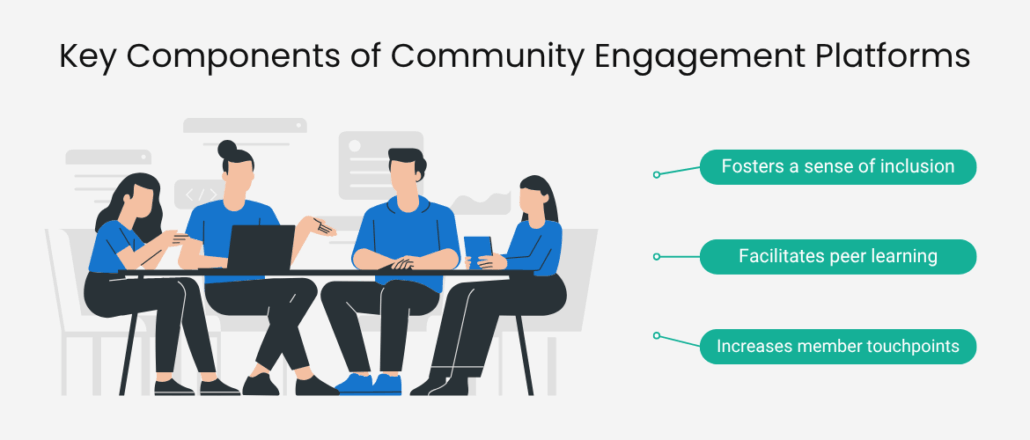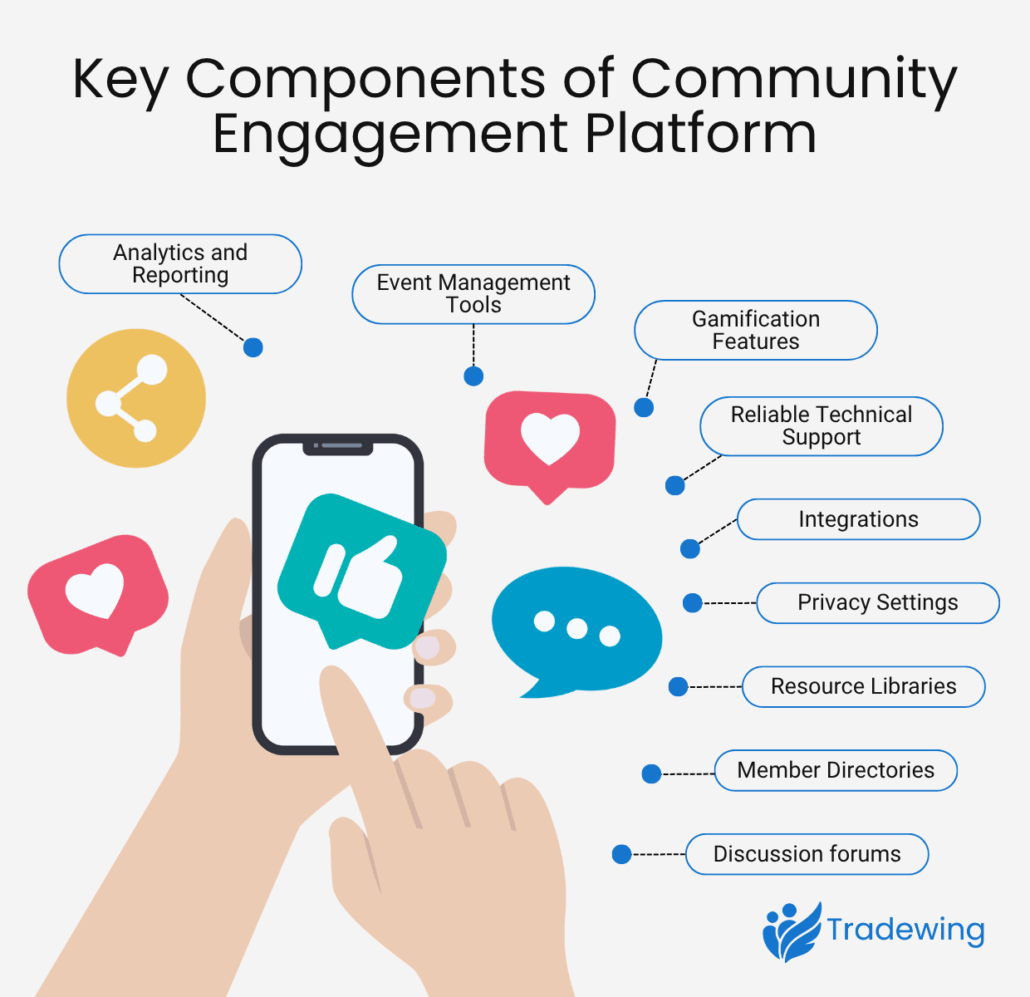Online communities have become essential infrastructure for modern associations.
With 76% of the world’s 5.5 billion internet users participating in online communities, these spaces are now a vital channel for reaching audiences and strengthening member connections.
But building a community that resonates with your members takes more than launching forums or hosting webinars. It requires intentional design, consistent care, and a clear understanding of how your members want to engage.
In this article, we’ll explore what drives thriving online communities today and how the right platform can make all the difference for your association.
What is An Online Community?
Gone are the days when a yearly conference and a quarterly newsletter were enough to keep members feeling connected. Members now expect continuous engagement, authentic interactions, and on-demand access to resources that help them succeed.
An online community is a digital space where members of a group can connect, collaborate, and communicate around a shared interest or goal. These spaces provide interactive environments where individuals can engage in real-time or have asynchronous conversations.
Unlike generic social media groups or forums, online communities offer controlled, branded environments where group leaders can moderate discussions, organize groups around subtopics, and monitor valuable engagement data. For associations like yours, this means tailoring the community’s focus to align with members’ interests and needs for a highly engaging experience.
Why Are Online Communities Important?
Associations thrive on successful member engagement and retention, and a strong online community supports both. Here’s how:

- Increases member touchpoints. Digital communities offer consistent touchpoints, helping members see continued value throughout the year rather than in just one or two offerings. As a result, members will become more connected to your association and more likely to renew their memberships.
- Facilitates peer learning. Members can learn from each other in an online community, whether through troubleshooting a problem, sharing ideas, or simply bonding over shared interests. Peer interactions lead to a stronger member network, which incentivizes members to continue engaging with your association.
- Fosters a sense of inclusion. When members become involved in a community, they’ll feel heard, seen, and connected to your larger organization. This sense of inclusion and belonging strengthens member loyalty to your association, increasing the likelihood they’ll retain their membership for the long haul.
Take the American Association of Physics Teachers (AAPT), for example. This organization relied on two in-person meetings each year to keep members connected. Then, they invested in an online community platform, Tradewing, that allowed members to engage with each other year-round.
Now, the organization’s Director of Membership, Mike Hall, says, “I really feel that when members renew their membership, they’re going to remember all of the activities and interactions, and all the different ways that they participated through the Tradewing platform.”
Watch the video below for more details about the benefits AAPT experienced from prioritizing an online community:
5 Online Community Traits Associations Shouldn’t Overlook
1. Shared Purpose
Before diving into tech, focus on why your community exists.
Every community needs a clear “why.” A successful community makes members feel aligned with the group’s mission, whether that be advancing their profession, advocating for industry standards, or fulfilling any other purpose.
Is it a hub for professional development? A place for peer-to-peer support? An advocacy network? Your community’s “why” should be the thread that ties every discussion, event, and interaction together.
2. Intuitive User Experience
You could have the most inspiring mission, but if members get stuck navigating the platform, engagement will stall.
A successful online community should feel natural to use. Choose an easy-to-use platform that feels familiar, so you can prioritize meaningful interactions over platform logistics. Demo the software to make sure it’s intuitive before committing to a solution and rolling it out to your members.
Remember: beyond compliance, accessibility should make member participation feel effortless.
3. Strong Community Management
Digital communities aren’t self-sustaining. They need effective management to welcome new members, nurture engagement, and monitor the community’s success.
Effective community management involves:
- Personalized onboarding
- Regular moderation check-ins
- Rotating engagement prompts
- Clear and visible community guidelines
Use a community management platform to facilitate these processes and designate team members in charge of overseeing them.
If placing just one individual in charge of community management won’t be effective, consider establishing ambassador programs with small, trusted groups of members who lead by example, spark conversations, and offer peer-level support across the platform. They can also be available to help troubleshoot problems or answer questions as members interact with your community.
4. Diverse Offerings
Today’s members look for ways to contribute on their own terms. A great digital community offers numerous ways for members to interact with each other, such as:
- Virtual events
- Polls and surveys
- Private groups or committees
The more varied the interactions, the more value members perceive their memberships to have. Plus, different offerings make it easier for your members to find a method of engagement that’s most comfortable to them. For example, your less social members may be more inclined to respond to a survey than directly engage with someone on a comment board.
5. Branding that Builds Belonging
Even if you’re hosting your digital community using community engagement software, it’s critical to avoid making members feel as though they’re visiting a third-party website.
Your online community should feel and look like an extension of your association. A strong digital community should reflect your organization’s identity, incorporating visual branding and tone elements such as:
- Your association’s color palette
- The organization’s logo
- Font styles used across your other platforms
- Voice and messaging style that match your other marketing materials
Follow visual branding best practices to ensure your community platform aligns visually with your other member-facing resources, like your association’s website. A robust community engagement platform often includes a website builder, enabling you to design both spaces in sync and create a seamless, familiar experience that reflects your brand.
When members step into your digital community, they should immediately feel at home.
What Are Online Community Platforms?
An online community platform is software that provides the tools needed to establish and facilitate a digital community, such as communication tools, event management features, and a social media-like interface where members can interact.
Unlike generic tools like Facebook or Slack, online community platforms are purpose-built to give your association full control over branding and the member experience. By allowing for deeper customization and features tailored to member-driven organizations, these platforms offer everything you’ll need to host a great digital community.
What To Look For In An Online Community Platform
Top-tier features of online community platforms include:

- Gamification features. Your online community platform should allow for points, badges, leadership boards, and other fun features that liven up member participation.
- Integrations. Your association likely uses other software for different purposes, and it should be easy to connect your online community platform with those existing systems.
- Analytics and reporting. To effectively manage your digital community, you’ll need reporting tools that track engagement metrics, such as the number of comments a member makes or the sizes of your subgroups.
- Reliable technical support. The best online community platforms are backed by a team of trustworthy and helpful technical experts who can answer any questions or troubleshoot problems you encounter.
- Discussions. Facilitating conversations between members is at the core of your digital community’s purpose, so the software you use should make this easy.
- Event management tools. Choose a platform that can handle registration, attendance, and other event management tasks that directly impact the member experience.
- Member directories. The right software will make it easy for members to find and network with one another by hosting browsable and customizable member directories.
- Privacy settings. In the same vein, your platform should make members feel comfortable sharing their personal information by giving them complete control over their profile and post share settings.
As with any platform your association uses, it’s important to note that different organizations may need different solutions. That’s why Tradewing offers a transparent view of our online community platform through personalized demos, so your team can see firsthand the features we offer to make hosting an online community a breeze.
In addition to requesting demos of potential online community platforms, consider reaching out to peer organizations in your network to ask what solutions they use. Recommendations from trusted organizations provide an insider’s look at the software you’re considering and can help you determine whether that solution would meet your needs, too.
How to Start an Online Community
Perhaps your organization is fully convinced that an online community is exactly what your members need. Good! Digital communities bring vast benefits to both your organization and its members.
However, strategic planning and several steps are required for a strong start:
- Choose the right online community platform. Research top solutions and compare them to your needs. Use the list of recommended features in the section above, as well as any must-have features your team identifies, to narrow down your options and select the best platform for your organization.
- Build the community’s framework. Determine the structure of your online community. Plan discussion topics and standards, establish onboarding procedures, and draft community guidelines that all participants must follow.
- Strategically promote the community’s launch. Generate excitement about your online community by sending personalized invitations or sharing public announcements. Highlight incentives, like exclusive resources or networking opportunities, to create a sense of urgency around joining.
- Monitor member engagement and optimize your efforts. Track member participation and use feedback to improve your community as needed. Review key performance indicators (KPIs) monthly or quarterly to assess ROI and areas for improvement.
By following these steps, your association can establish a strong foundation for a dynamic and sustainable online community.
Final Thoughts: Communities Are Built, Then Nurtured
With thoughtful strategy, user-friendly technology, and an engaged member base, your digital space can become a trusted space for connection and belonging.
If your association is planning to build or refresh its online community, start by defining what success looks like from your members’ perspective. Identify the features that matter most, explore platforms that align with your goals, and know that you don’t have to get it perfect on day one.
Begin with intention. Stay open to learning. Keep nurturing the space.
If you’re looking to learn more about the software that can boost your community’s success, here are a few more resources to check out:
- Community Management Software for Associations: 10 Options
- 6 Excellent Higher Logic Alternatives: Comparing Features
- 10 Best Community Engagement Platforms To Boost Renewals










